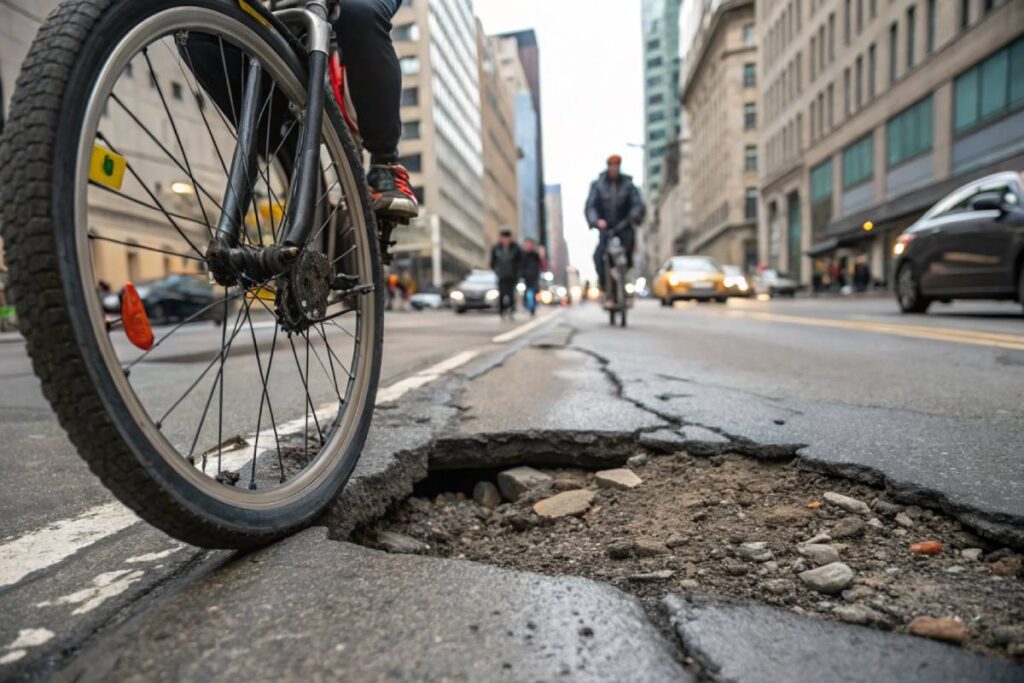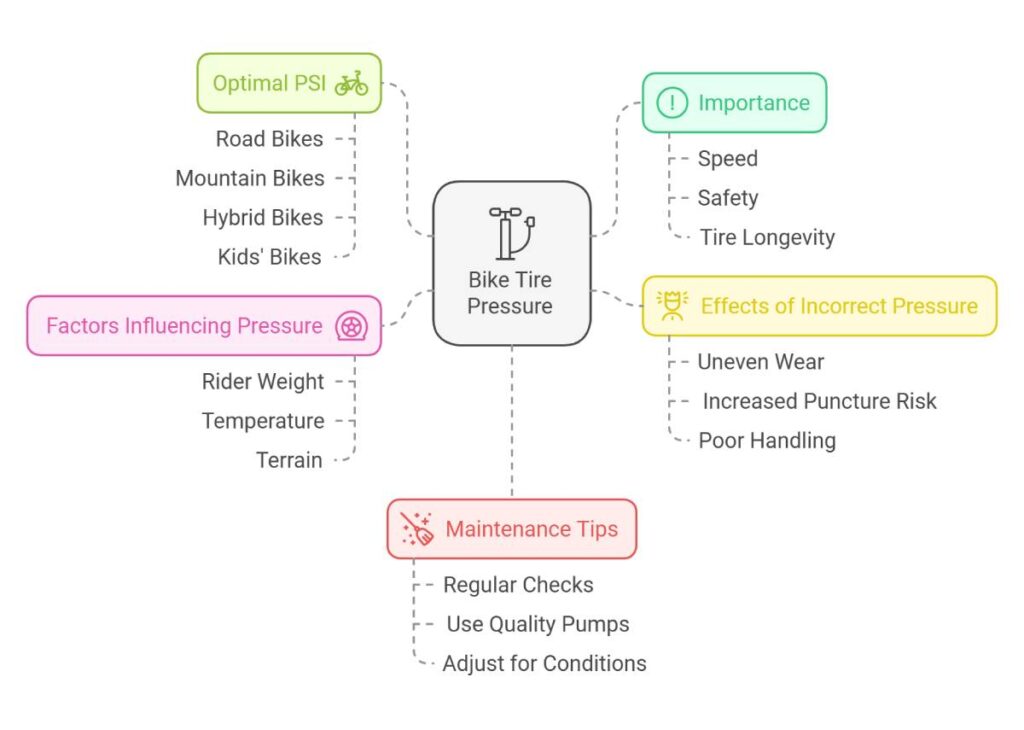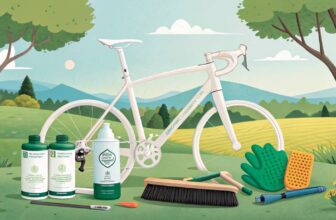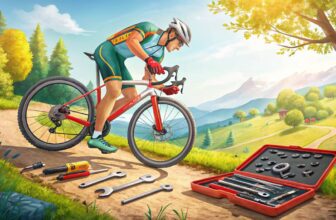Ready to elevate your cycling experience? Understanding the right bike tire pressure is your ticket to smoother rides, enhanced safety, and longer-lasting tires. Whether you’re a seasoned road warrior or a casual trail explorer, mastering tire pressure can transform your journey from mundane to exhilarating.
Imagine gliding effortlessly over diverse terrains, avoiding unexpected flats, and maximizing your bike’s performance—all by simply dialing in the perfect air pressure.
Let’s dive into the essentials of bike tire pressure and unlock the secrets to a superior cycling adventure.
Importance of Proper Tire Pressure
Look, nobody wants to end up on the side of the road throwing a tantrum because tire pressure turned your smooth ride into a fight with physics. Getting that sweet spot of tire pressure ensures you’re not just gliding efficiently but staying safe and keeping those tires going for the long haul.
Effects of Low Tire Pressure
Do you know that saggy tire feeling? Tires squatted low on air can bring a truckload of troubles. We’re talking uneven wear, like your favorite sneakers all scuffed up on just one side. It’s no mystery that poor tread can lead to slip-slidey adventures. Frequent fixes get old, fast—whether you’re a daily pedal-pusher or a traipse-around-town type. Plus, it hits the wallet.
Rolling along with low pressure? It’s like biking through glue. More air equals less sticky pedal battles, and if you’re the type chasing speed records, low pressure is no friend of yours. It also makes tires more like bubble wrap ready to pop—punctures are just a sharp pebble away.
| Issue | Effect of Low Tire Pressure |
|---|---|
| Premature Wear | More often swapping out those tires |
| Rolling Resistance | Harder pedal strokes, slower speeds |
| Traction | Less grip, more slips |
| Puncture Risk | Flats are basically waiting to happen |
Dangers of Overinflated Tires
On the flip side, pumping tires to rock hardness has its own drama. Overinflated tires lack the bounce to handle bumps like debris or potholes. Its rock over squish approach isn’t the best when cruising over city streets.

And blowouts? Yeah, that’s a recipe for a wild ride, but not the good kind. Blowouts can wreck braking, turning a calm stoppage into a nail-biting moment. Overinflated tires have all the give of a brick, leading to slip-ups, especially when Mother Nature throws in a surprise drizzle.
| Issue | Effect of Overinflated Tires |
|---|---|
| Ride Comfort | Feels like a jackhammer—ouch! |
| Tire Damage | More vulnerable to road bumps |
| Safety Risks | Blowouts and poor braking mean yikes! |
| Traction | Skipping town on grip |
Keeping your air game on point is essential for anyone who hops on a bike. It’s simple: get that pressure just right and you’ll ride smoother, safer, and with fewer pit stops. Want to become a real bike maintenance whiz? Check out our schedule for keeping everything in ship shape, and snag some know-how from our repair guides.

Recommended Tire Pressure Levels
Nailing the right tire pressure for your bike isn’t just a bunch of hot air—it’s about keeping your ride smooth, safe, and speedy. Let’s break it down for road bikes, mountain bikes, hybrids, and kids’ bikes, so you can keep pedaling without a hitch.
Road Bikes
For road warriors who crave speed, road bikes need a higher tire pressure to cut down on resistance and boost velocity. Generally, you’re looking at 80 to 130 psi. If you’re feeling ultra-competitive and like living on the edge, you might crank it up to 160 psi.
| Tire Type | Recommended PSI | Use Case |
|---|---|---|
| Road Bike | 80-130 | Regular rides |
| Racing Tires | Up to 160 | High-stakes racing |
Curious about perfecting your road bike’s pressure? Swing by our bike tire pressure guide for more insights.
Mountain Bikes
Bouncing over rocks and roots demands some cushion. Mountain bikes thrive with lower pressures between 30 and 50 psi, giving you the right mix of grip and bump absorption.
| Tire Type | Recommended PSI | Use Case |
|---|---|---|
| Mountain Bike | 30-50 | Trails and off-road antics |
Want to keep your mountain beast in top shape, even in chilly climes? Check out our winter bike maintenance guide.
Hybrid Bikes
Like a good mash-up song, hybrid bikes bring together road and trail vibes. Aim for 50 to 70 psi to glide the streets or tackle light trails without a fuss.
| Tire Type | Recommended PSI | Use Case |
|---|---|---|
| Hybrid Bike | 50-70 | City cruising and casual trails |
Need help with hybrid upkeep? Discover tips in our bike repair guides.
Kids’ Bikes
Let’s keep the kiddos comfy! Kids’ bikes roll best at a friendlier 20 to 40 psi. Lower is often better for tiny legs and new riders.
| Tire Type | Recommended PSI | Use Case |
|---|---|---|
| Kids’ Bike | 20-40 | Everyday adventures |
For nurturing your mini cyclist’s wheels, dig into our bike maintenance schedule.
Getting that tire pressure dialed in makes every ride better—safer, smoother, and oh-so-enjoyable. Whether you’re a seasoned cyclist or just want to keep the gears of your little one’s bike in tip-top shape, our guides on cleaning your bike chain and adjusting your bike brakes have got your back!
Factors Affecting Tire Pressure
Rider Weight
Rider weight plays a big role in how much air your bike tires need. If you’re on the heavier side, you’ll want to pump up the tires with more air to keep everything riding smoothly and avoid mishaps like tire pinch or unnecessary wear.
Think of it as your bike needing a bit more muscle to carry you around. For instance, someone who’s tipping the scales at 200 pounds should aim for about 20 extra psi compared to someone who weighs 160 pounds. Here’s a quick reference table for you:
| Rider Weight | Recommended Tire Pressure (psi) |
|---|---|
| 160 lbs | 80 – 100 |
| 180 lbs | 90 – 110 |
| 200 lbs | 100 – 120 |
Of course, don’t forget to tailor these numbers to your specific bike, how and where you ride, and what feels comfy for you. Regularly checking your tire’s pressure ensures a longer life for those tires and a much happier ride overall. For an all-you-need-to-know guide on bike upkeep, take a look at our bike maintenance schedule.
Temperature Influence
Ever noticed how tires sometimes seem softer when it’s cold and a bit too hard when it’s hot? That’s the temperature at work. When it gets warm, the air inside your tires expands, boosting pressure. Conversely, cooler weather contracts the air, lowering pressure. Keep an eye on this when you’re switching between climates or seasons.
And one more thing: using rim brakes creates friction, which can also warm up tires and jack up the pressure. So, think about letting some air out when this happens.
Here’s a handy chart:
| Temperature | Tire Pressure Variation (psi) |
|---|---|
| Cold (Below 50°F) | Decreases by about 1-2 psi per 10°F drop |
| Hot (Above 80°F) | Increases by about 2-3 psi per 10°F rise |
Did you get the chill vibes of winter affecting your ride? Check out our winter bike maintenance for some savvy tips.
Grasping how these factors play into your ride will keep your bike in tip-top shape and ensure you’re cruising safely. For more on bike care and fixes, don’t miss out on our detailed bike repair guides.
Tire Pressure and Performance
Impact on Rolling Speed
Tire pressure has a massive say on how quickly and smoothly you roll. It’s like your bike is having a conversation with the ground—get the pressure wrong, and it’s all awkward pauses. When you let a bit of air out, moving from 40 psi to 30 psi, your speed dips by a smidge, just 1.3%. Push it even lower to 20 psi, and it’s like your bike’s put on a little weight—3.8% less power and 3.1% slower speed.
At a squishy 10 psi, you’re dragging, slowing more than 20%, and feeling that extra 14% burn when climbing compared to riding at 40 psi (Singletracks).
Optimizing Performance
Here’s the big tip: keep those tires at or above 20 psi. Slacking on this means sluggish performance. Staying at 20 psi or up means you glide better and save energy—a lifesaver for racers focused on shaving off seconds. Imagine the heartbreak of losing nearly a minute in a 90-minute race just because your tires weren’t pumped right. It’s like forgetting your lucky socks on the big day.
| Tire Pressure (psi) | How Fast You Roll (%) | How Much Power You Have (%) |
|---|---|---|
| 40 | Standard | Standard |
| 30 | -1.3% | -1.3% |
| 20 | -3.1% | -3.8% |
| 10 | -20% | -20% |
The Role of Tire Suppleness
Turns out, it’s not all about cranking up the pressure. Enter, tire suppleness. Supple tires, like the lazy cat of the tire world, run lower without slowing you down. For all-road rides, these wider, lower-pressure tires are a game changer. Modern research backs it up: balance that pressure with suppleness for a smoother, faster ride without needing to go rock-hard on pressure (Rene Herse Cycles).
Get your pump wisdom right, and your rides will be smoother and speedier. Want to keep your ride in check? Peek at our bike maintenance schedule, figure out how to fix a bike flat tire, and find the best bike multi-tools you should stash for those just-in-case moments.
Conclusion
Achieving the perfect bike tire pressure is more than a maintenance task—it’s a fundamental aspect of optimizing your cycling performance and safety. Whether you’re speeding down city streets on a road bike, tackling rugged trails with a mountain bike, navigating mixed terrains on a hybrid, or ensuring your child’s bike rides are smooth and safe, understanding and maintaining the right tire pressure is crucial.
Remember, under-inflated tires lead to sluggish rides and increased puncture risks, while over-inflated tires can cause harsh rides and potential blowouts. Additionally, factors like rider weight and ambient temperature play pivotal roles in determining the ideal pressure for your specific needs.
By regularly checking and adjusting your tire pressure, you not only enhance your riding experience but also extend the life of your tires, saving you time and money in the long run.
Equip yourself with the knowledge from our comprehensive guides and recommended maintenance schedules to keep your bike in peak condition. Embrace the power of proper tire inflation and transform every ride into a seamless, enjoyable journey.
Stay proactive with your bike care, and let every pedal stroke bring you closer to cycling excellence.
FAQs
What is the ideal tire pressure for my bike?
The ideal tire pressure varies based on your bike type and riding conditions. Road bikes typically require 80-130 psi, mountain bikes 30-50 psi, hybrids 50-70 psi, and kids’ bikes 20-40 psi. Always refer to your tire’s sidewall for manufacturer recommendations.
How often should I check my bike’s tire pressure?
It’s advisable to check your tire pressure at least once a week and before every long ride. Regular checks ensure optimal performance and help prevent unexpected flats.
Can incorrect tire pressure affect my bike’s handling?
Yes, both under-inflated and over-inflated tires can negatively impact your bike’s handling. Under-inflated tires can cause sluggish responses and increased puncture risks, while over-inflated tires may lead to a harsh ride and reduced traction.
How does rider weight influence tire pressure?
Heavier riders require higher tire pressure to support their weight and prevent excessive tire deformation. Conversely, lighter riders can use lower pressures for better traction and comfort. Adjust according to your weight and riding style.
What tools do I need to maintain proper tire pressure?
A reliable floor pump with a pressure gauge, or a digital pump, is essential for maintaining accurate tire pressure. Additionally, carrying a portable mini pump or CO2 inflator on rides can be handy for on-the-go adjustments.
Final Thoughts
Proper bike tire pressure is a simple yet powerful tool in every cyclist’s arsenal. It bridges the gap between a good ride and an exceptional one, ensuring that every pedal stroke is efficient and every journey is safe.
By taking the time to regularly check and adjust your tire pressure, you’re investing in the longevity of your tires, the safety of your rides, and the overall enjoyment of cycling.
Whether you’re gearing up for a competitive race, embarking on a rugged mountain trail, navigating urban streets, or ensuring your child’s bike is ready for daily adventures, understanding and maintaining the right tire pressure is essential.
Embrace these practices, explore our comprehensive guides, and ride with confidence knowing you’ve optimized one of the most critical aspects of your bike. Here’s to countless smooth, safe, and exhilarating rides ahead!
Key Tips Around Bike Tire Pressure
- Regular Checks: Inspect your tire pressure at least once a week and before long rides.
- Use a Quality Pump: Invest in a floor pump with an accurate pressure gauge for precise inflation.
- Know Your Tires: Always refer to the manufacturer’s recommended PSI range on the tire sidewall.
- Adjust for Conditions: Lower tire pressure for rough terrains and higher pressure for smooth, paved roads.
- Consider Rider Weight: Heavier riders may need higher pressure within the recommended range to prevent pinch flats.
- Account for Temperature: Adjust tire pressure based on weather changes to maintain optimal performance.
- Carry Essentials: Always have a portable pump or CO2 inflator and a spare tube on your rides.
- Suppleness Matters: Balance pressure with tire suppleness for a smoother and faster ride.
- Inspect Tires Regularly: Look for signs of wear, embedded debris, or damage that could affect performance.
- Educate Yourself: Utilize resources and guides to stay informed about best practices in bike maintenance.
Recommended Biking Products and Accessories
- Floor Bike Pump with Gauge
- Example: Topeak JoeBlow Sport III Floor Pump – Reliable and accurate with a sturdy base.
- Portable Mini Pump
- Example: Lezyne Micro Floor Drive Mini Pump – Compact and easy to carry for on-the-go adjustments.
- Digital Pressure Gauge
- Example: SKS Precision Digital Tire Gauge – Provides precise readings for optimal inflation.
- CO2 Inflator Kit
- Example: Pro Bike Tool CO2 Inflator Kit – Quick and efficient inflation solution during rides.
- Tire Repair Kit
- Example: Park Tool AK-5 Tire Levers and Patch Kit – Essential for fixing flats anytime, anywhere.
- Multi-Tool for Bikes
- Example: Crankbrothers M19 Multi-Tool – Comprehensive toolset for various bike maintenance tasks.
- High-Quality Bike Tires
- Example: Continental Gatorskin Road Bike Tires – Durable and puncture-resistant for long-lasting performance.
- Tubeless Tire Conversion Kit
- Example: Stan’s NoTubes Tubeless Kit – Enhance tire suppleness and reduce puncture risks.
- Bike Pressure Booster
- Example: Specialized Air Tool Pro Mini Pump – Boost your tire pressure quickly and efficiently.
- Temperature-Resistant Valve Caps
- Example: Pedro’s PED26 Valve Caps – Protect your valves from extreme temperatures and debris.
- Smart Bike Pump with App Integration
- Example: NiteRider Smart Pump – Monitor and adjust tire pressure via smartphone for precision and convenience.
- Bike Maintenance Stand
- Example: Feedback Sports Velo Stand – Keep your bike upright and stable while performing maintenance tasks.
By equipping yourself with these essential tools and accessories, maintaining the optimal tire pressure becomes a seamless part of your biking routine, ensuring every ride is as enjoyable and efficient as possible.




